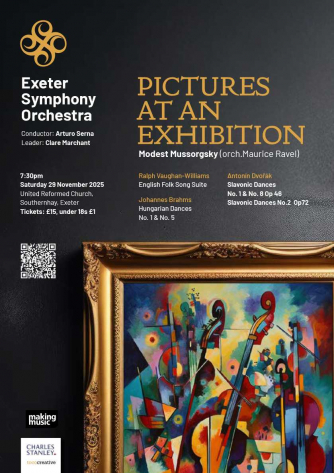Details
Southernhay United Reformed Church
Dix's Field
Exeter
Devon
EX1 1QA
England
Programme
Johannes Brahms – Hungarian Dance in G minor no.1, WoO 1
Johannes Brahms – Hungarian Dance in F sharp minor, WoO.1 no.5
Antonin Dvorak – Slavonic Dance in E minor, Op.72 no.2
Antonin Dvorak – Slavonic Dance in G minor, Op.46 no.8
Antonin Dvorak – Slavonic Dance in C major, Op.46 no.1
Ralph Vaughan Williams – English Folk Song Suite
~ Interval ~
Modest Mussorgsky – Pictures at an Exhibition (orch. Ravel)
Performers
Arturo Serna – Conductor
Exeter Symphony Orchestra
Programme Note
Two great composers crafted the centrepiece of our Winter Concert. Mussorgsky wrote Pictures at an Exhibition for piano, but its unique format and memorable tunes subsequently inspired orchestrations by Henry Wood in 1915 and, more famously, Maurice Ravel in 1922; we will play the later work.
First though, to open the folk song theme of the concert’s first half, it’s the ever-popular Hungarian Dances 1 and 5 (WoO1) by Johannes Brahms(1833-1897), published in 1869. Inspired by Liszt – and following in the folk-influenced footsteps of Haydn and Boccherini – Brahms saw the potential of these distinctive gypsy themes which are now among his most oft-performed works. We hope you will be inspired to tap your feet!
After Brahms’s commercial success with his Ungarische Tänze and written at the instigation of the same, savvy publisher, two collections of eight Slavonic Dances by Antonín Dvořák (1841-1904) offer sound images of Bohemia which enjoy equal popularity; we will play Nos 1 & 8 (Op 46)and No 2 (Op 72). Incidentally, Brahms was a great friend and admirer of the younger composer; he once commented that “I should be glad if something occurred to me as a main idea that occurs to Dvořák only by the way”.
Ralph Vaughan Williams (1872-1958) wrote the (English) Folk Song Suite for military/concert band in 1923 and his student, Gordon Jacob, arranged it for concert orchestra the following year, adding ‘English’ to the title for publication. Nine folk songs – most collected by RVW himself – feature across two marches and an intermezzo; all are amply infused with the ‘pastoral’ style which characterises The Lark Ascending (1914) and the Fantasia on ‘Greensleeves’ (1934). This suite ranks among his most lively and popular works.
Pictures at an Exhibition by Modest Mussorgsky (1839-1881), orchestrated by Ravel (1875-1937), is our finale. Originally written as a tribute to his close friend, the artist Viktor Hartmann after his sudden death in 1873, this impressive piece not only vividly depicts eleven of his paintings, but includes ‘promenades’ to suggest a viewer’s progress around the gallery. The breadth of Mussorgsky’s imagination is unparalleled and the images conjured range from eerie, through playful to majestic. Although the original piano version is intense, Ravel’s interpretation adds great colour and undeniably contributes to the work’s huge appeal.

 Your events at Classical Events
Your events at Classical Events

